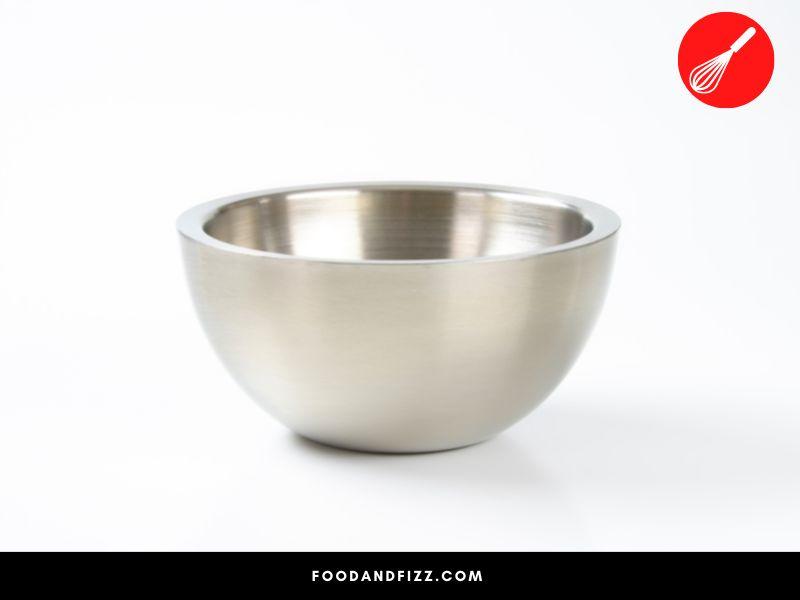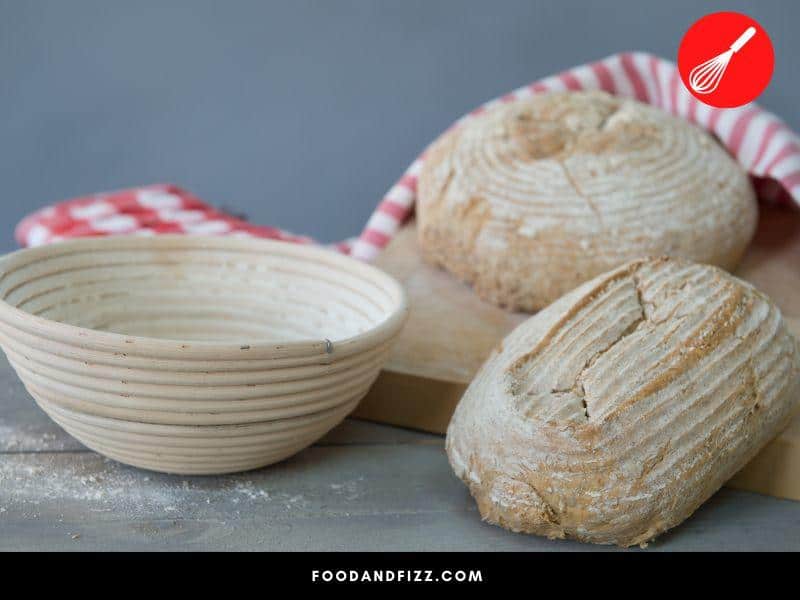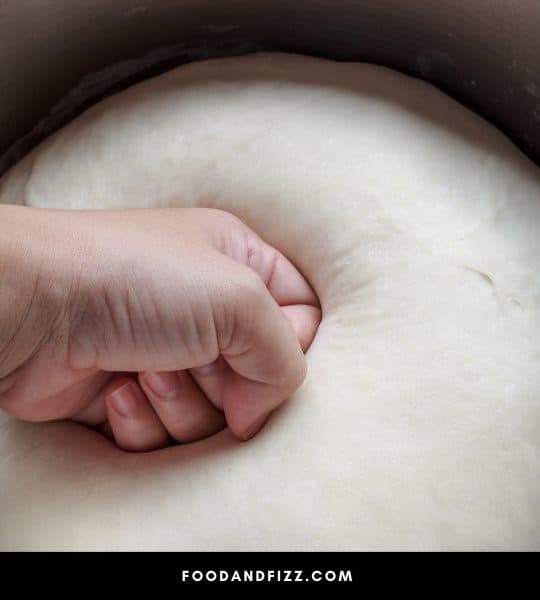One of the coolest things you can experience as a baker is seeing your bread dough fluff up and rise. It’s pretty awesome to witness a seemingly inanimate piece of dough come alive and double up in size, all because you sprinkled in a few teaspoons of yeast.
An appropriate rise in your dough is important in the texture of your final product, so more than the ingredients you put in and the method you used, the container you use to let your dough rise also plays a big part in the success of your baking endeavor.
Plastic and glass containers are often by bakers for this purpose. But what about metal? Can bread rise in a metal bowl?
Can Bread Rise in A Metal Bowl?
Bread dough can rise in a non-reactive metal bowl like stainless steel but not in reactive ones like copper, cast iron or aluminum. Reactive metals can impart unpleasant tastes and may hinder the action of the yeast in your dough or worse, kill the yeast altogether. Food-grade plastic containers, glass, and ceramic bowls are other options that can be used for dough rising.

Can Bread Rise in a Metal Bowl?
Using the right container for your bread dough to rise is extremely important (Read: “What Should I Cover Bread Dough With While It’s Rising?”) Choosing the wrong container can affect the texture of your final product or worse, kill the yeast in your dough and leave you with a sad, dense chunk of bread.
Bread dough can be placed in metal bowls to rise, but the type of metal matters. Reactive metals like copper, cast iron, and aluminum can do serious damage to your dough and even kill off your yeast.
Yeast is very sensitive to metal ions and certain metal alloys like brass are known to kill off yeast instantly, which, needless to say, will not bode well for your bread dough.
Stainless steel bowls, though, are non-reactive and are ideal for this purpose. They will not interfere with your bread dough rising, will not affect the yeast, and will not impart unnecessary tastes to your dough.
This is also why stainless-steel bowls and utensils are a staple in most kitchens. Stainless steel bowls may safely be used to let your bread dough rise. They do not stain, do not absorb odors, and are safe to use.

Why Does Dough Need Rising?
One of the most important steps in bread baking is the rising or fermentation part. This step is what gives bread its structure and its well-loved flavor and aroma.
It is the step where, having provided the yeast with ample food source and placing it in a warm, comfortable and conducive environment, you encourage the yeast to do what it’s supposed to do to give your bread some structure, taste, and personality. To put it simply, this step is what makes bread, well, bread.
Without this step, the bread will be dense and flat, and will not have its characteristic flavor. In general, the longer the rise, the more developed the flavor of the bread.
The choice of a rising container is important as we already discussed. Using a reactive metal container will interfere with and hamper this process, causing issues in your final product.
The Importance of Yeast
Yeast that’s healthy and happy is important in successful bread baking. Before you even start, it is important to check that your yeast is still viable and up to the job of making bread.
Yeast that froths and bubbles after mixing with water and sugar is active yeast that can get the job done. If your mixture does not do anything, the yeast is dead, and it’s best to start over.
When your yeast froths and bubbles, it is ready to be mixed with the other ingredients and kneaded to form a dough. When the dough is formed, it is ready to be left on its own for a few hours to let the yeast do what it is supposed to do.

Fermentation
During the rising step, the dough undergoes a process of fermentation, and the yeast is the main star of the show.
What basically happens is that the yeast feeds on the broken-down sugars in the flour, and releases carbon dioxide and alcohols that gives bread its light and airy structure and its distinct aroma and flavor.
The more that the yeast eats and produces carbon dioxide, the bigger the rise in the bread. The longer it stays in the process, the more fermentation, and thus, more flavor.
Temperature is Key
We’ve established that these two processes are important in making good bread: yeast eats and produces carbon dioxide to give way to airy bread, and yeast produces alcohols in fermentation to give bread its flavor.
However, both these processes cannot happen too fast. Bread that rises too fast will not have much flavor, as it needs time to sit in fermentation to develop flavors. This is where temperature comes in.
Temperature is what drives the yeast to do what they do. The warmer the temperature, the more active they become, that’s why it is important to find the right temperature that both rising and fermentation can occur in compromise with each other.
According to experts, this “sweet spot” is between 75°F – 78°F. It is the ideal temperature to let the dough rise which will give it enough time to allow flavor and texture to develop.
Best Type of Bowls to Use for Bread Rising
So now that we know how important the process of rising is in making bread, we have to make sure that everything is in order as we allow the yeast to work its magic.
Aside from ensuring that the dough sits at the ideal temperatures, we should also make sure that it’s given enough space to work and expand by choosing a bowl big enough to contain the dough, and choosing the right bowl material to help it along.
What are the best types of bowls to use for bread rising? Let’s check out 4 options below.
1. Stainless Steel Bowl
Stainless steel bowls are non-reactive and will not interfere with the action of the yeast in your dough. They will not leach tastes into your bread dough.
Clean-up is a breeze and they come in different sizes. Most professional kitchens use stainless steel bowls in their food preparations, and it is an ideal vessel to use for rising your bread dough.
Most kitchen stand mixers are also made of stainless steel so if you are mixing your bread dough in a mixer, it offers that convenience as well. Stainless steel also allows you to cool or warm your dough as necessary to achieve the desired temperature.

2. Plastic Bowl
You can also let your dough rise in a bowl made out of plastic. As long as it is food-grade, plastic will not adversely affect the yeast in your dough.
Most home cooks actually prefer this as it is something most people have readily available in their homes. In commercial bakeries, plastic is also a popular choice as a bread-rising container.
3. Glass Bowl
Glass bowls may also be used for your dough rising needs, but as they are more fragile than stainless steel or plastic bowls, they need to be handled more carefully.
But if that is the only thing you have, it should not pose a problem for your dough. Being transparent, it also gives the added advantage for the baker to monitor the rise of the dough.
4. Ceramic Bowl
Ceramic bowls are decorative and pretty and are a nice addition to any kitchen. However, they can chip pretty easily, which makes them a bit more sensitive than the other bowls. However, they are also non-reactive and can be used for rising bread dough.
5. Bannetons
Bannetons, also known as brotforms are proofing baskets specifically used for proofing sourdough, and is what gives it its characteristic round shape, and structured and patterned design.
They are commonly made of rattan but can also be made of cane, wood, wicker, cotton, and plastic. The typical shape is round but other shapes and sizes are also available, and they are very popular with artisan bakers. It is good to have especially for sourdough but not absolutely necessary.
No matter what container you choose, as long as you don’t choose reactive bowls and as long as you choose a big enough bowl and keep your dough rising at the ideal temperatures, and follow the procedures in your recipe, your bread will most likely turn out fine.

Frequently Asked Questions to Can Bread Rise In A Metal Bowl?
Why is My Bread Dough Not Rising?
If your bread dough is not rising, it could be because your yeast is inactive and not good anymore, the room your dough is in is too cold, your dough is not kneaded enough, or the proportion of your ingredients is incorrect.
Can Dough Rise in a Plastic Bowl?
As long as it is food-safe, bread dough can rise in a plastic bowl.
Can you Make Sourdough in a Stainless-Steel Bowl?
Stainless steel is non-reactive and poses no threat to your sourdough. You can make sourdough and let it rise in a stainless-steel bowl.
Conclusion to Can Bread Rise in a Metal Bowl?
Bread can rise in a metal bowl as long as it is a non-reactive metal bowl like stainless steel. Other metals like copper, aluminum, and cast iron are reactive and will hamper the action, if not kill, your yeast and consequently, your bread dough.
Choosing the right container, with the right size, and keeping your dough at the ideal rising temperatures ensures that you get bread that’s light and airy and flavorful, and worth all the effort you will put into it.

